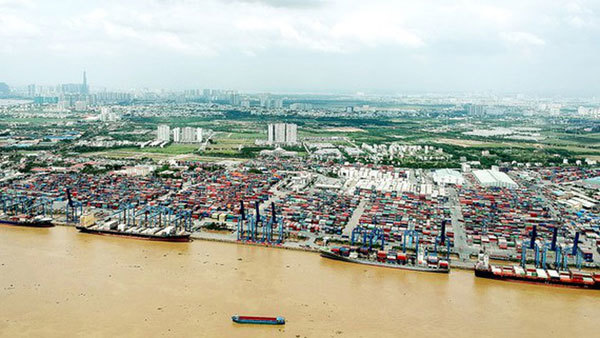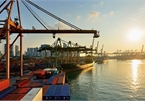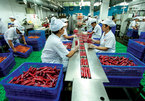account for an increasingly high proportion in the structure of the gross regional domestic product (GRDP), thereby, helping the city to improve the role of the hub for domestic goods exchange and connection with the international market, contributing to reducing the rate of national logistics costs against the national GDP.
 |
| Tan Cang - Cat Lai Port in Thu Duc City. (Photo: SGGP) |
Small-scale logistics enterprises
The country currently has about 4,000 professional enterprises. Of which, the leading multinational logistics enterprises in the world have already been present in Vietnam. The size of Vietnam's logistics service market is small, at about 2-4 percent of GDP, but its growth rate is extremely high, estimated to increase by 20-25 percent per year. Importantly, the Vietnamese economy is forecasted to still outperform in Southeast Asia in the next 10 years. The advantage of a coastline stretching from North to South and the fast-developing e-commerce industry are plus points for the development of logistics.
It raised the question that why, up to now, Vietnam has not fully exploited the potentials of logistics. Mr. Ha Ngoc Son, Head of the Import-Export Management Department under the Department of Industry and Trade of HCMC, explained that the team of logistics enterprises is large but not strong. Their business is quite small. Most domestic enterprises only provide basic services, services for small supply chains with little added-value or outsourcing to foreign companies, and do not have differentiated services or programs. The financial potential of Vietnamese logistics enterprises is weak, with 80 percent of established enterprises having charter capital of a few billion Vietnamese dongs. They lack separate voices with shipping lines, so they are controlled in terms of price. In the long term, price competition will no longer exist. Instead, the quality and variety of service will be the decisive factor for the development of logistics enterprises.
According to Mr. Ha Ngoc Son, the development of logistics in HCMC is facing many challenges because the infrastructure fails to meet its requirements and becomes an obstruction. The inland container depot (ICD) system has exceeded its designed capacity and five out of six ICDs in the city have decided to relocate, so they operate separately with a poor association, and domestic connectivity is weak. The level of fees of each port has not been unified. Fees and tolls remain high, and there are many other costs incurred on the road that enterprises cannot list. In the context of more and more FDI enterprises investing in logistics for e-commerce, if Vietnamese enterprises are not linked, creating a closed service system to compete with them, they will possibly lose their market share right on home ground.
Which direction for development?
According to the project of developing the logistics industry in HCMC to 2025, with a vision to 2030, the total capital needed for the development of the logistics industry in the 2020-2030 period in HCMC is about VND95.8 trillion. Mr. Ha Ngoc Son said that the project would solve many problems not only for the city but also for the region if we developed a feasible implementation plan.
Regarding the development orientation, according to Mr. Bui Ta Hoang Vu, Director of the Department of Industry and Trade, digital transformation and information technology application should be considered as an inevitable and priority trend of the logistics industry in the 2021-2025 period, with two strategic tasks: to focus on developing logistics for the e-commerce industry and providing a service chain for import and export goods to Asian markets and transshipment to Cai Mep - Thi Vai Port to Europe and America.
Assessing the current situation of the city's logistics industry, Mr. Le Kim Cuong, Deputy Director of Tan Cang Logistics Service Center, said that it is necessary to consider transforming the functions, turning Cat Lai Industrial Park into the logistics center of the city. It is difficult to find new land banks to develop logistics centers, but there are a few places that the city can consider the conversion. For example, there are no logistics services behind Cat Lai Port, so the city can consider the Cat Lai Industrial Park nearby. Is it possible to relocate enterprises in the industrial park to other areas to transform its functions into a logistics service center?
There was also an opinion said that HCMC should use its meager land fund to build research centers and train human resources for logistics to develop sustainably. This human resource will provide for not only HCMC but also the entire southern region. At that time, when referring to HCMC’s contribution to logistics, it will be brainpower, technology, and high-quality human resources.
With the project of developing the logistics industry in the area of HCMC, the State just builds the overall project, determines the location and the policies, while the implementation and operation are done by businesses. The centers will be built and developed completely by major infrastructure investors, and they only use a part of the centers. In each subdivision, there will be component investors who sublet to divide for partners. Therefore, to attract capital from enterprises to concentrate investment in developing the logistics industry as expected, it is necessary to have outstanding support from the State on mechanisms and policies, as well as perfecting the connection in traffic infrastructure. It is essential to work closely with provinces to form a hub in the logistics service sector, connecting regions across the country, in the context that many of the city's key export industries tend to gradually shift to other provinces.
Dr. Tran Du Lich, a member of the Prime Minister's Economic Advisory Group, said that if a leading ecosystem in the logistics sector was not established in HCMC, which locality would be able to do this? Therefore, the implementation needs to be considered carefully and get opinions from many dimensions so that we have a quick, successful, and correct plan.
|
Seven logistics centers |
SGGP

Fresh port charges hit HCM City’s logistics
Despite strong objections among businesses, Ho Chi Minh City will start collecting infrastructure and service fees at seaports from July 2021, triggering concerns over logistics cost increases.

HCM City approves 8 projects to boost industry, trading, e-commerce, exports
The HCM City Department of Industry and Trade said eight key projects have been approved by the city government to promote the industry, trading, e-commerce, and exports and facilitate goods transport.